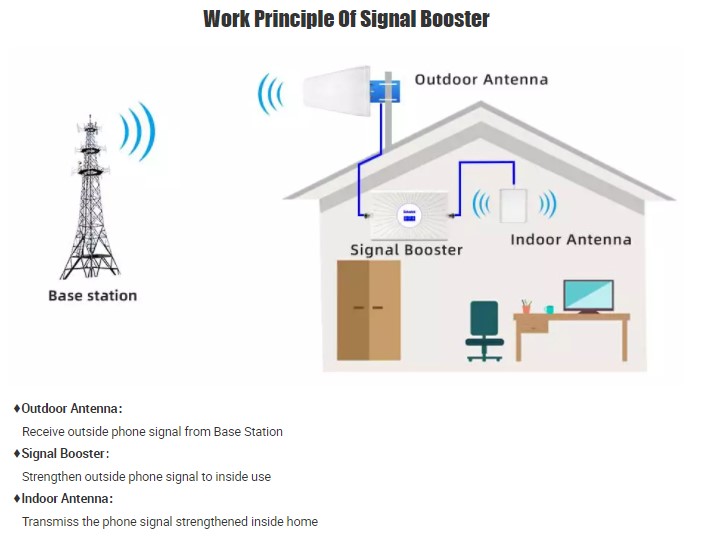Mobile phone signal booster, also known as repeater, is composed of communication antennas, RF duplexer, low noise amplifier, mixer, ESC attenuator, filter, power amplifier and other components or modules to form uplink and downlink amplification links.
Mobile phone signal booster is a product specially designed to solve the blind zone of mobile phone signal. Since mobile phone signals rely on the propagation of electromagnetic waves to establish communication contact, due to the blockage of buildings, in some tall buildings, basements and other places, some shopping malls, restaurants, entertainment venues such as karaoke, sauna and massage, underground civil air defense projects, subway stations, etc., in these places, mobile phone signals cannot be reached and mobile phones cannot be used.
Lintratek mobile phone signal booster can solve these problems very well. As long as a mobile phone signal booster system is installed in a specific place, people can receive good cell phone signal everywhere as you cover the whole area there. Here is a pic simply to show how does the mobile booster work.

The basic principle of its work is: use the forward antenna (donor antenna) to receive the downlink signal of the base station into the repeater, amplify the useful signal through the low-noise amplifier, suppress the noise signal in the signal, and improve the signal-to-noise ratio (S/N ratio). ); then down-converted to the intermediate frequency signal, filtered by the filter, amplified at the intermediate frequency, and then up-converted to the radio frequency by frequency shifting, amplified by the power amplifier, and transmitted to the mobile station by the backward antenna (retransmission antenna); at the same time, the backward antenna is used. The uplink signal of the mobile station is received, and is processed by the uplink amplification link along the opposite path: that is, it is transmitted to the base station through a low noise amplifier, a downconverter, a filter, an intermediate amplifier, an upconverter, and a power amplifier. With this design, two-way communication between the base station and the mobile station can be possible.
Installation instructions and precautions:
1. Model selection: Choose suitable model according to coverage and building structures.
2. Antenna distribution plan: Use directional Yagi antennas outdoors, and the direction of the antennas should point to the transmitting base station as much as possible to achieve the best reception effect. Omnidirectional antennas can be used indoors, and the installation height is 2-3 meters (The antenna amount and location depend on the indoor area and indoor structure), only one indoor antenna needs to be installed for an indoor unobstructed range of less than 300 square meters, 2 indoor antennas are required for a range of 300-500 square meters, and 3 are required for a range of 500 to 800 square meter.
3. Mobile phone signal booster installation: generally installed at more than 2 meters above the ground. The distance between the installation location of the equipment and the indoor and outdoor antennas should be routed with the shortest distance (with the longer the cable, the greater the signal attenuation) to achieve the best effect.
4. The selection of wires: the standard of the feeder of the signal booster of radio and television (is cable TV) is 75Ω, but the mobile phone signal booster is the communication industry, and its standard is 50Ω, and the wrong impedance will deteriorate the system indicators. The thickness of the wire is determined according to the actual situation on site. The longer the cable, the thicker the wire for reducing the attenuation of the signal. Using a 75Ω wire to make the host and wire mismatched will increase the standing wave and cause more interference problems. Therefore, the selection of wire should be differentiated according to the industry.
The signal sent by the indoor antenna cannot be received by the outdoor antenna, which will cause self-excitation. Generally, the two antennas are separated by 8 meters to avoid self-excitation.
Lintratek, professionally solve mobile phone signal problems! Please contact us for customer service.
Post time: Jul-05-2022







